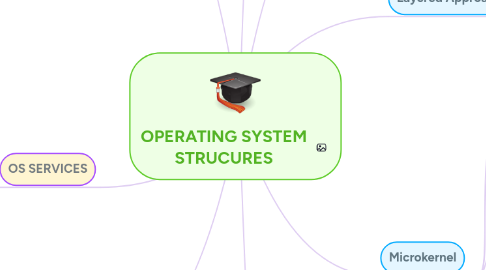
1. SYSTEM CALL
1.1. Known as assembly-language insruction
1.2. Provide interface between a running program and OS
1.3. Methods used to pass parameters
1.3.1. parameter in register
1.3.2. parameter stored in a block
1.3.3. parameters placed, or pushed onto the stack
1.4. Types of System Call
1.4.1. Process control
1.4.2. File management
1.4.3. Device Management
1.4.4. Information Maintenance
1.4.5. Communications
1.4.6. Protection
2. OS SERVICES
2.1. User interface
2.2. Program Execution
2.3. I/O operations
2.4. File-system manipulation
2.5. Communication
2.6. Error Detection
3. OS DESIGN
3.1. Design of system
3.1.1. choice of hardware
3.1.2. type of sytem
4. Layered Approach
4.1. Divided into number of layers
4.1.1. Bottom layer (layer 0) = hardware
4.1.2. Highest layer (layer N) = user interface
4.2. Advantages
4.2.1. Simplicity of construction and debugging
4.3. Disadvantages
4.3.1. The careful definition and interaction of the layers
4.3.2. Less efficient
5. Microkernel
5.1. Small OS core
5.2. Contains only essential core OS functions
5.3. Many services traditionally included in OS
5.3.1. Device drivers
5.3.2. File systems
5.3.3. Virtual memory manager
5.3.4. Windows System
5.3.5. Security Services
5.4. Benefits
5.4.1. Extensibility
5.4.2. Flexibility
5.4.3. Reliability
5.4.4. Portability
6. ADDITIONAL OS FUNCTIONS
6.1. Resource allocation
6.2. Accounting
6.3. Protection and security
7. COMMUNICATION MODELS
7.1. message passing
7.2. shared memory
8. OS DESIGN GOALS
8.1. User Goals
8.1.1. convenient to use
8.1.2. easy to learn
8.1.3. reliable
8.1.4. safe
8.1.5. fast
8.2. System Goals
8.2.1. easy to design
8.2.2. easy to implement
8.2.3. easy to maintain
8.2.4. flexible
8.2.5. error-free

